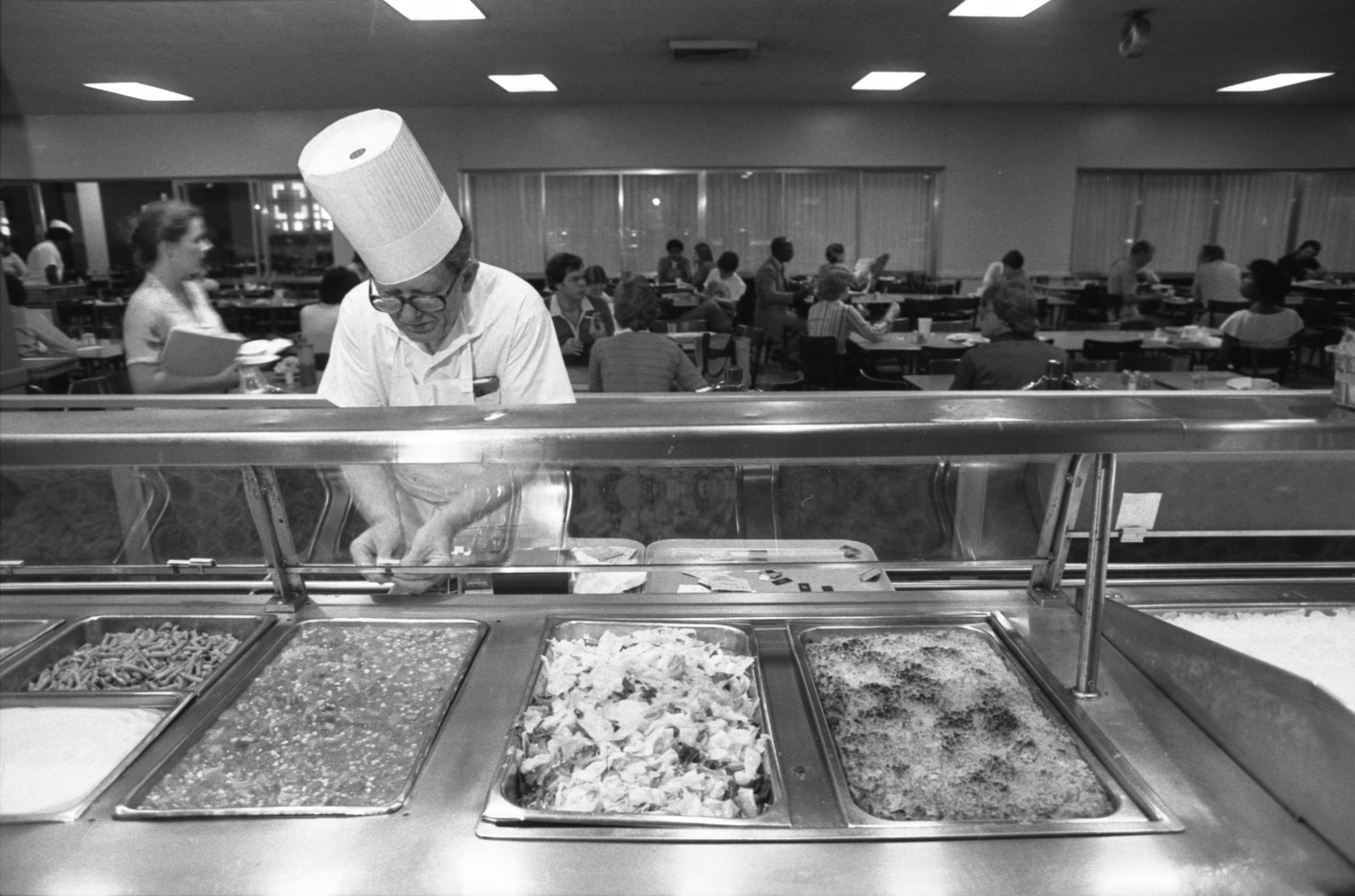
While we all know packing lunch is the most frugal food option, traveling around campus clutching your wallet is no easy task. Under the Courtland Street Bridge lives a constant, thick aroma of peanut oil and waffle fries, pillaging the underground, soaking your clothing and assaulting your nose. The air is thick with the smell of Chick-fil-A. But it wasn’t always this way.
Today, you have the honor of sharing campus with this Chick-fil-A as there are now more dining options then there ever were 85 years ago. So jump out of your Pontiac and let’s take a trip through time and food courts.
Named after the men who started it, Emory Brooks and Carl Dixon, the “B&D” was campus’ main cafeteria in the Student Center. It originally started in the basement of Kell Hall, relocated to Sparks Hall and finally found its home in what is now the Panther’s Club located in the Student Center East in 1964.
Because of Georgia State’s humble origins as a night school, there were few options for food on campus. Some of the most affectionately remembered are the B&D and the Refectory, a small snack bar on the bottom floor of Kell Hall.
The B&D was one of the only places that offered a variety of hot food options on campus, and it was widely liked by both students and professors. An excerpt from the 1986 Rampway, Georgia State’s late yearbook, reads:
“Menus are based on certain basics such as providing a choice between poultry, fish and beef dish everyday…Regulars at the cafeteria will remember Mary Lou’s broccoli casserole.”
The joint was so popular and the scarce seating was so valuable, the owners had to place a sign enforcing “no studying between 10 am and 2 pm.”
It was so good and inexpensive, for example, that people from all around the offices downtown would commute to the university for their lunch. The school began to make students present their student ID when buying food, a practice they still enforce to this day.
The Assistant Director for Recreational Facilities, Allen Wilbanks, remembers that the food was so delicious, former President Noah Langdale Jr. indulged himself with two milkshakes every day.
“Dr. Langdale had the brothers send 2 milk shakes every day at 2 to his office,” Wilbanks said. “Friday was a dozen fried shrimp or flounder and fries for $2.00 at lunch and dinner. It was said that their deserts, especially the cheesecake, were wonderful.”
Dr. John Burrison, regents professor of folklore in the English department, first came to Georgia State in 1966. At the time, the university’s campus consisted of just three buildings: Kell Hall, Sparks Hall and part of what is now the library.
Burrison said the B&D was no exception to student ridicule. Students colloquially renamed the B&D as the “Bite and Die” or, better yet, the “Botulism and Dysentery.”
Burrison remembers the snacks offered in the Refectory, a snack bar at the bottom of Kell Hall. Students began affectionately referring to the Refectory as the “Rat Factory” after one incident in which its floors were replaced and a nest of rats was discovered residing underneath.
But this business wasn’t without controversy. Behind the excellent food of the B&D was the staff that worked diligently to prepare it and in the 1990s, a group of students recognized that the cafeteria staff of the B&D, all people of color, were lacking the proper benefits they deserved and instituted a protest.
Another issue came to light when The Signal’s then-editor-in-chief, D.W. Pine, uncovered the near-monopoly that Brooks and Dixon had on the cafeteria by preventing external bids on the space since 1948. This article sparked an uprising that would ultimately lead to the eventual sale of the business.
“These protests forced the administration to put it out to bid,” Wilbanks said.
The competition of new dining facilities on campus forced the B&D to “modernize,” leading to an overall change in food choices and quality. Notably, the past’s southern, home-style meals, like veggies and casseroles, were replaced with more streamlined and savory options, like wings, pizza and cookies.
But this change didn’t sit well with everyone, as the new options lacked a certain comfort and nutrition that the B&D provided. Burrison was one of those people.
“The last time I ate there was just after they converted the hot food area to something with wings,” he said. “In fact, I wrote a letter to the food service complaining that you couldn’t get a nice healthy, well-balanced and inexpensive meal there anymore.”
PantherDining works to satisfy the students as best they can, evolving the restaurants to fit the students’ wants and needs over time. With a changing student body, the on-campus restaurant options must follow suit.
“When the university was a commuter school, there wasn’t a need for a variety of dining options, but as the university continued to grow and transform into a traditional university, the need for variety grew, as well,” Amanda Shoff, a public relations specialist for PantherDining, said.
In Student Center East, changes included the arrival of a Pizza Hut, which was eventually replaced by Ray’s New York Pizza. Einstein Bros. Bagels eventually became a Burrito Bowl, and the previous Burger King soon became Far East Fusion.
Shoff said, “While the traditional cafeteria style was popular in the 1960s, as branded concepts became more popular, the students’ desire to have them on campus increased, and when students started living on campus, their desire for 24-hour service became prevalent.”
In 2017, PantherDining assumed control of the entirety of dining facilities on campus, including The Courtyard, Panther’s Club and Centennial Café. They are responsible for the rehoming of the Chick-fil-A from a smaller, shared space in the Panther’s Club to its present residence today, beneath the Courtland Street Bridge which assaults your nose with every passing by.
You can thank them for the $25 you shell out every week in the name of golden nuggets and polynesian sauce.
